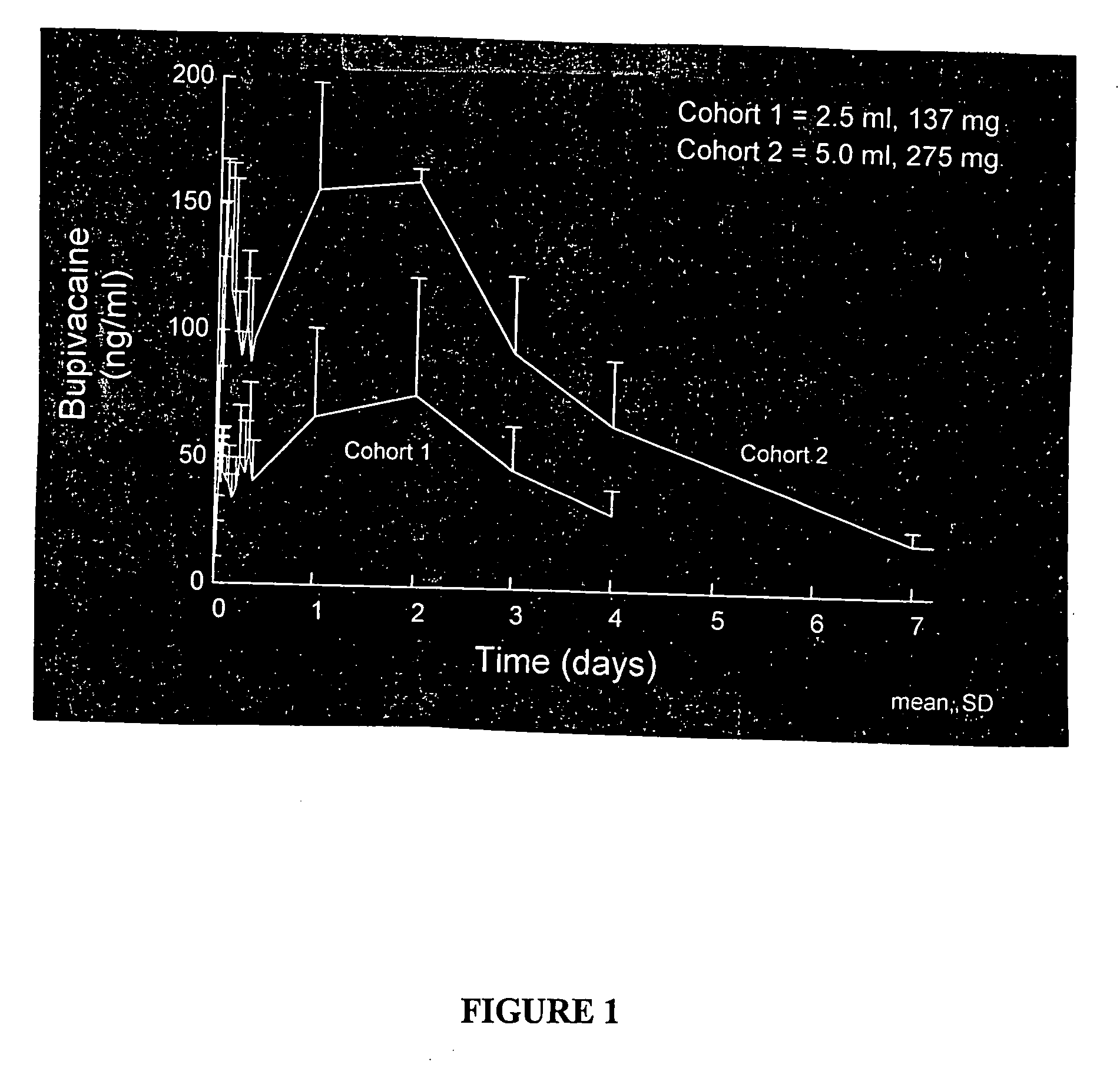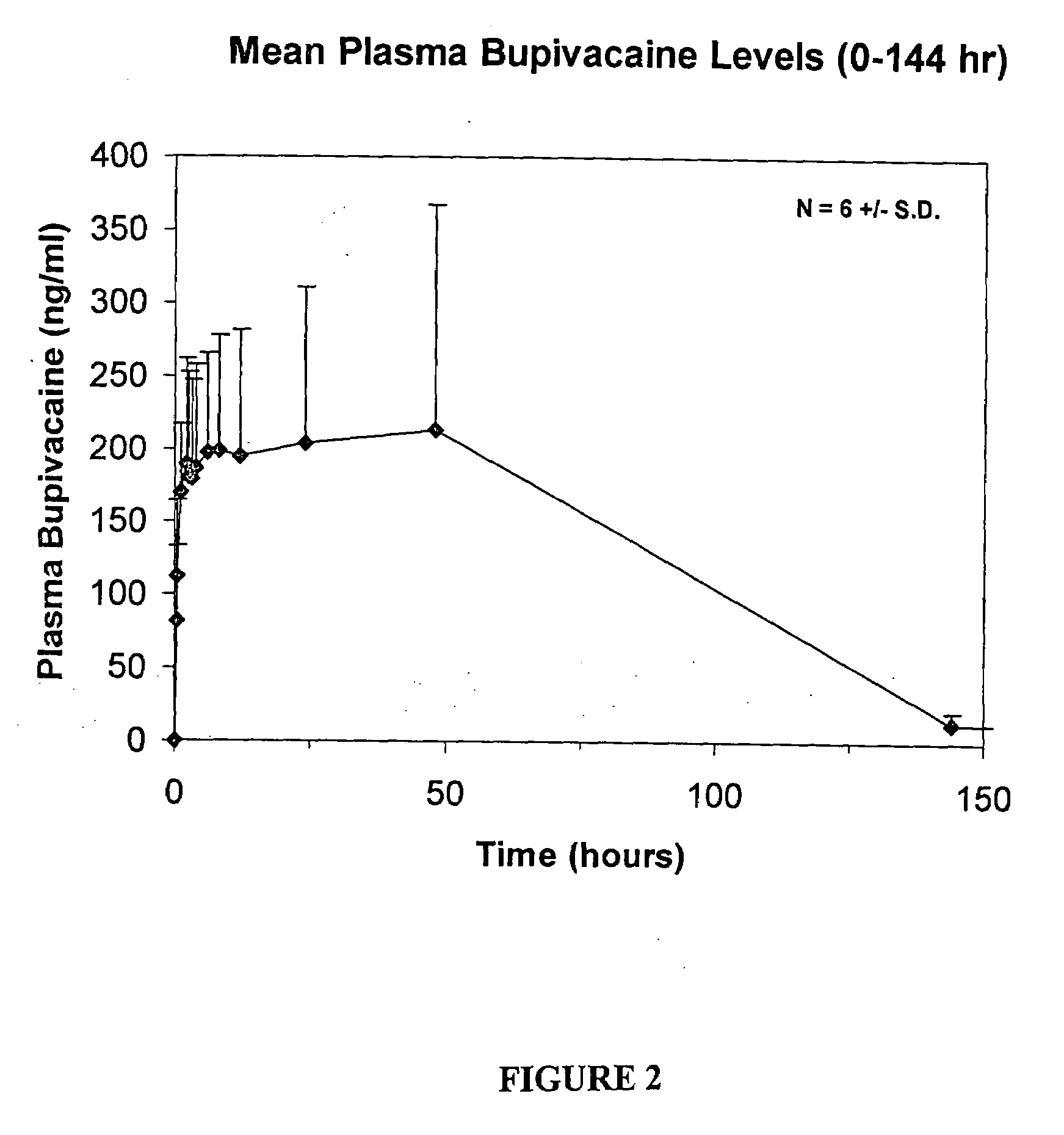Controlled delivery system
a delivery system and control technology, applied in the direction of prosthesis, non-skid devices, drug compositions, etc., can solve the problems of having to provide enhancers, unable to avoid systemic initial burst release of anesthetics, and difficulty in overcome certain disadvantages of polymeric systems
- Summary
- Abstract
- Description
- Claims
- Application Information
AI Technical Summary
Benefits of technology
Problems solved by technology
Method used
Image
Examples
example 1
[0155]A non-polymeric liquid carrier system containing an anesthetic agent was produced as follows. Sucrose acetate isobutyrate (SAIB) was combined with a N-methylpyrrolidone (NMP) solvent for the SAIB carrier to provide a 70:30 mixture. To this mixture either 2.5% (w / v) or 5% bupivacaine (free base) was added to provide two test compositions.
[0156]Male Sprague Dawley Rats, (275 to 300 g) were split into two test groups of 8 animals each. The test formulations were administered into the quadrupeds using needle and syringe to deliver either 25 or 50 mg doses of the bupivacaine. The skin flinch response test was then used to determine the presence of a local anesthetic effect, wherein involuntary flinch upon cutaneous stimulation using a pin applied to 10 random areas within 1 cm of the base of the injection site. Percent inhibition of pin-perception was then calculated by taking the baseline response minus the test response, divided by the baseline response and multiplied by 100.
[015...
example 2
[0158]Subjects. Male, Fisher 344 rats (Charles River Laboratories) (N=96) were used for the study. Animals were kept on a reversed light:dark cycle (dark 5:00 to 17:00) in a temperature and humidity controlled vivarium. Rats were given ad lib access to food and water except during experimental sessions. All experiments were conducted during the dark phase of the light:dark cycle. All procedures were approved by the Institutional Animal Care and Use Committee of Wake Forest University Health Sciences Center.
[0159]Surgical procedure. Following induction of anesthesia with 5% isoflurane vapor in oxygen, animals were shaved on the left lower quadrant of the abdomen. Anesthesia was maintained throughout the surgical procedure using 2.0 to 2.5% isoflurane vapor in oxygen. A 3 cm incision was placed 0.5 cm below and parallel to the lowest rib on the left side, penetrating into the peritoneal cavity. The viscera and musculature were vigorously manipulated by inserting 5 to 7 cm of the index...
example 3
[0173]The following dose escalation, safety and pharmacokinetic evaluation was carried out in healthy human volunteer subjects in order to assess the safety / tolerability and preliminary pharmacokinetic performance of controlled release bupivacaine compositions comprising a sucrose acetate isobutyrate non-polymeric carrier.
[0174]The compositions were formulated using bupivacaine free base formulated in a sucrose acetate isobutyrate (SAIB) non-polymeric carrier further including N-methyl-2-pyrrolidone (NMP) that acts as a solvent for the bupivacaine and the SAIB carrier. The composition was prepared by combining the SAIB carrier and NMP solvent (70:30 vehicle) with 5 wt % of bupivacaine, to provide individual dosages containing 137.5 mg of the bupivacaine in a 2.5 mL injection volume. The composition was provided as an injectable liquid.
[0175]There were two Cohorts in the study. Cohort 1 was comprised of 6 healthy male subjects, aged from 22 to 38. For Cohort 1, all subjects received ...
PUM
| Property | Measurement | Unit |
|---|---|---|
| concentration | aaaaa | aaaaa |
| concentration | aaaaa | aaaaa |
| viscosity | aaaaa | aaaaa |
Abstract
Description
Claims
Application Information
 Login to View More
Login to View More - R&D
- Intellectual Property
- Life Sciences
- Materials
- Tech Scout
- Unparalleled Data Quality
- Higher Quality Content
- 60% Fewer Hallucinations
Browse by: Latest US Patents, China's latest patents, Technical Efficacy Thesaurus, Application Domain, Technology Topic, Popular Technical Reports.
© 2025 PatSnap. All rights reserved.Legal|Privacy policy|Modern Slavery Act Transparency Statement|Sitemap|About US| Contact US: help@patsnap.com



